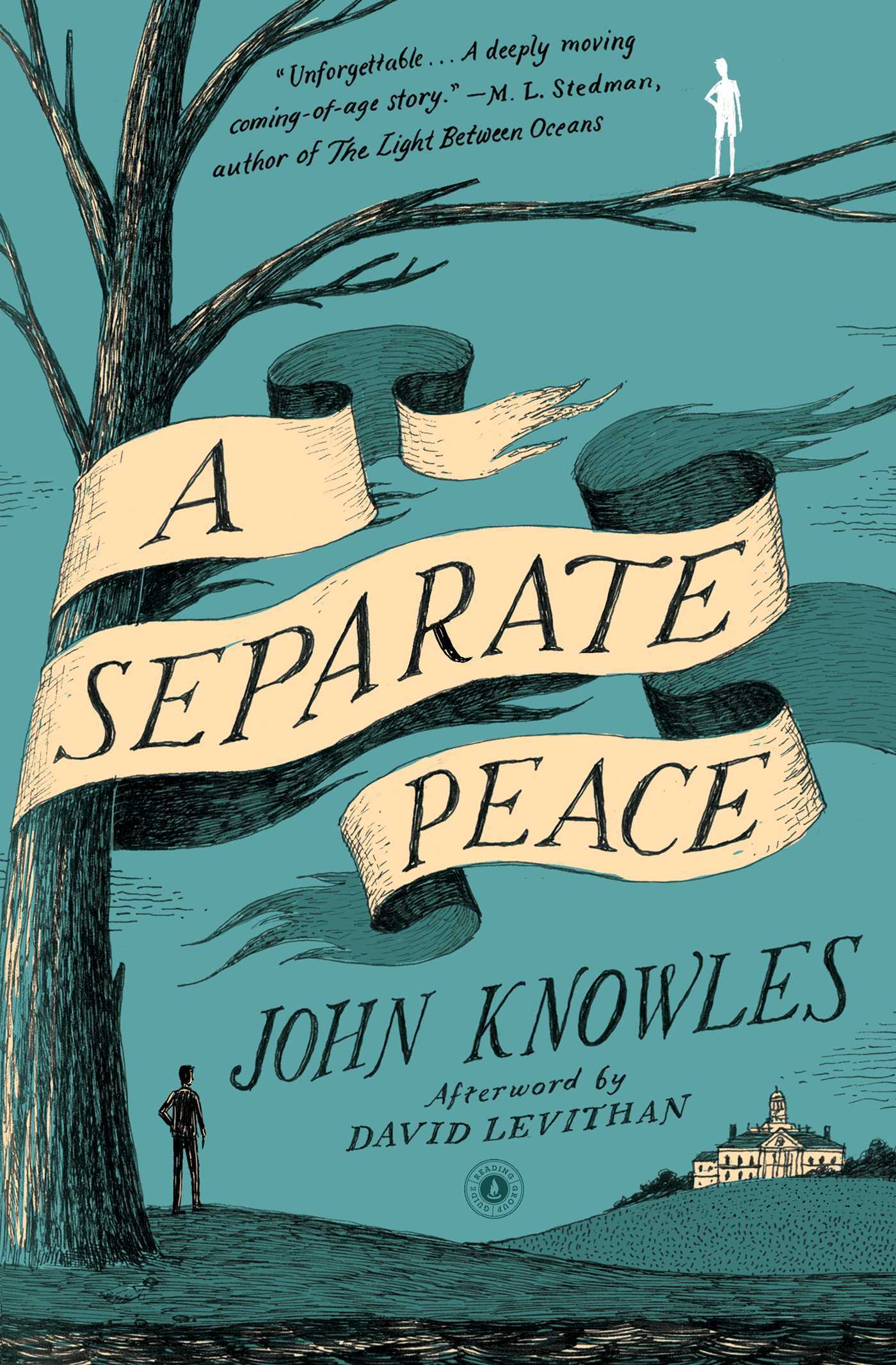A Separate Peace by John Knowles
A Separate Peace is a captivating novel written by John Knowles, first published in 1959. Set against the backdrop of World War II, the story unfolds at Devon School, an elite New England boarding school, where the protagonist, Gene Forrester, grapples with the complexities of friendship, rivalry, guilt, and the loss of innocence. With its introspective narrative and thought-provoking themes, A Separate Peace continues to resonate with readers, exploring the profound impact of war on individuals and the human psyche.
The novel is primarily a bildungsroman, a coming-of-age tale that delves into the inner struggles of its characters. At the heart of the story is the complex relationship between Gene Forrester and his charismatic roommate, Phineas, known as Finny. Gene is an introverted and academically inclined young man, while Finny embodies athletic prowess, charm, and an adventurous spirit. Despite their stark differences, they develop a strong bond, and their friendship becomes the central focus of the narrative.
Throughout the novel, Gene wrestles with a deep sense of envy and resentment towards Finny. The envy stems from his perception of Finny’s effortless ability to excel in sports and his unwavering popularity. As Gene’s envy grows, it manifests in a pivotal moment when he jostles a tree limb, causing Finny to fall and shatter his leg. This act, initially portrayed as an accident, exposes the darker undercurrents of Gene’s emotions and sets the stage for the exploration of guilt and its consequences.
The aftermath of the accident forces Gene to confront his guilt and question his own motives. He grapples with the duality of his actions, struggling to understand whether he intentionally caused Finny’s fall out of jealousy or if it was a result of an unconscious impulse. Gene’s internal struggle reflects the broader theme of the novel—the inherent conflict between the individual’s desire for personal achievement and the bonds of friendship.
As the story progresses, the war takes on a more prominent role, providing a metaphorical backdrop for the characters’ personal battles. The war acts as a catalyst for the loss of innocence, as the boys at Devon School grapple with the harsh realities of the world beyond their privileged bubble. Gene and his peers navigate the fear, uncertainty, and loss that come with the war, ultimately leading them to question their own identities and the purpose of their lives.
One of the most memorable aspects of A Separate Peace is its vivid and evocative setting. The tranquil Devon School, with its lush landscapes and idyllic atmosphere, contrasts sharply with the tumultuous events of the outside world. This stark juxtaposition highlights the fragility of innocence and the inevitable intrusion of the harsh realities of life.
Knowles’s prose is both introspective and eloquent, allowing readers to delve into the psyche of Gene and experience his conflicting emotions firsthand. The narrative is infused with poignant symbolism, such as the “separate peace” that Gene seeks—a temporary refuge from the chaos of the world around him. This desire for peace, both internal and external, becomes a driving force for Gene as he seeks to reconcile his guilt and find redemption.
Ultimately, A Separate Peace is a poignant exploration of the human condition, delving into themes of friendship, envy, guilt, and the loss of innocence. Through its vivid characters and evocative setting, the novel forces readers to confront their own vulnerabilities and the complexities of human relationships. John Knowles’s masterpiece continues to resonate with audiences, reminding us of the profound impact that war and personal choices can have on shaping our lives.
Key Facts
Here are some key facts about the novel “A Separate Peace” by John Knowles:
- Author: “A Separate Peace” was written by American author John Knowles. He was born on September 16, 1926, in Fairmont, West Virginia, and passed away on November 29, 2001, in Fort Lauderdale, Florida.
- Publication: The novel was first published in 1959 by Macmillan Publishers.
- Setting: The story is set during the years 1942-1943 at Devon School, a fictional all-boys preparatory school in New Hampshire. The backdrop of World War II heavily influences the events and atmosphere of the story.
- Genre: “A Separate Peace” is a coming-of-age novel and can be classified as both literary fiction and historical fiction.
- Protagonist: The protagonist and narrator of the novel is Gene Forrester. The story is primarily told from his perspective, providing insight into his inner thoughts, emotions, and experiences.
- Major Characters:
- Phineas (Finny): Gene’s charismatic and athletic roommate, who becomes his closest friend.
- Brinker Hadley: Gene’s confident and politically active classmate, known for his leadership qualities.
- Leper Lepellier: A quiet and introspective student who experiences a significant change due to the war.
- Cliff Quackenbush: A student who serves as a minor antagonist to Gene and Finny.
- Themes:
- Friendship and Rivalry: The complex dynamics between Gene and Finny, including jealousy, admiration, and betrayal, form a central theme of the novel.
- Guilt and Innocence: Gene’s struggle with guilt after causing Finny’s accident explores the loss of innocence and the consequences of one’s actions.
- Identity and Self-Discovery: The characters’ journey towards self-understanding and the search for personal identity are explored throughout the novel.
- War and Its Effects: The impact of World War II on the characters’ lives, their perspectives, and the loss of innocence are major themes in the story.
- Significance and Reception: “A Separate Peace” is considered a classic of American literature and has garnered both critical acclaim and popularity among readers. It has been studied in schools and universities, exploring its themes, symbolism, and narrative style.
- Adaptations: The novel was adapted into a film in 1972, directed by Larry Peerce. It has also been adapted for the stage multiple times.
- Awards: While the novel did not win any major literary awards, it has been widely praised for its compelling storytelling, memorable characters, and exploration of universal themes.
These key facts provide a foundation for understanding and appreciating the novel “A Separate Peace” and its enduring relevance in the literary landscape.
Major Characters
- Gene Forrester: The protagonist and narrator of the story, Gene is a thoughtful and introspective student at Devon School. He struggles with feelings of envy and guilt in his relationship with his roommate, Finny. Gene undergoes a journey of self-discovery and confronts the complexities of friendship and the loss of innocence.
- Phineas (Finny): Gene’s charismatic and athletic roommate, Finny is portrayed as the embodiment of grace, charm, and fearlessness. He excels in sports and possesses a magnetic personality that draws others to him. Finny’s friendship with Gene is both inspiring and complicated, forming the emotional core of the novel.
- Brinker Hadley: Brinker is a confident and assertive student at Devon School. He is known for his leadership qualities and his involvement in various school activities. Brinker challenges the status quo and encourages Gene to confront the truth about Finny’s accident, ultimately playing a significant role in the story’s resolution.
- Leper Lepellier: Leper is initially depicted as a quiet and introverted student who finds solace in nature. However, the war has a profound impact on him, leading to a deterioration in his mental health. Leper’s experiences highlight the devastating effects of war on individuals and add depth to the novel’s exploration of identity and innocence.
- Cliff Quackenbush: Cliff is a student at Devon School and serves as a minor antagonist to Gene and Finny. He represents the more conventional and competitive aspects of school life, often engaging in confrontations with Gene and asserting his superiority over others.
These major characters in “A Separate Peace” contribute to the novel’s exploration of friendship, rivalry, guilt, and the loss of innocence. Each character brings a unique perspective and challenges the protagonist’s beliefs, ultimately shaping the narrative and its themes. Their interactions and personal journeys offer insights into the complexities of human relationships and the profound impact of external circumstances on individual lives.
Minor Characters
- Mr. Prud’homme: He is the substitute headmaster at Devon School during the summer session. Mr. Prud’homme symbolizes authority and discipline, and his strict demeanor contrasts with the more relaxed atmosphere created by the students.
- Chet Douglass: Chet is a student at Devon School who participates in various athletic activities. He represents the typical competitive and conformist nature of the students at the school, embodying the qualities that Gene struggles with and ultimately rebels against.
- Mr. Ludsbury: He is the strict and stern headmaster of Devon School. Mr. Ludsbury’s character serves as a symbol of the strict educational system and societal expectations that the students must navigate.
- Quackenbush: He is the crew manager at Devon School and clashes with Gene during his brief stint as assistant crew manager. Quackenbush’s character highlights the conflicts and power dynamics within the school’s social hierarchy.
- The Devon School Teachers: Various teachers at Devon School play minor roles in the novel, representing authority figures who impart knowledge and shape the students’ experiences. They serve as a backdrop to the students’ lives and contribute to the institutional environment of the school.
- The Devon School Students: Aside from the major characters, there are other students who inhabit the school’s environment. While they may not have distinct personalities, their collective presence emphasizes the shared experiences, camaraderie, and peer pressure that influence the students’ actions and choices.
These minor characters, though they may not receive as much focus as the major characters, contribute to the overall atmosphere, conflicts, and themes of the novel. They provide glimpses into the broader context of the story and help shape the dynamics between the major characters, adding depth and complexity to the narrative.







